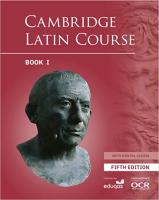
CUP (2022, fifth edition) p/b 250pp £19.95 (ISBN 9781009162647)
The Cambridge Latin Course has suffered some criticism in recent years either because it has not been revised to meet new examination requirements or because it has not reflected the diversity of society within the Roman Empire. To give more prominence to the women in Caecilius’ household, a daughter called Lucia (after Caecilius’ praenomen) is created. This, along with the introduction of female characters in some of the minor roles, involves some rewriting.
For example in stage 3 the painter (pictor) is no longer Celer, but a woman called Clara (an artifex). In Stage 10 Lucia is out walking near the palaestra with Melissa when they catch sight of Alexander, a talented young Greek and a close friend of Quintus. When Melissa asks if she fancies him, Lucia blushes. End of story? No. In stage 11 Caecilius asks Holconius to suggest a suitable husband for Lucia. His suggestion—the rich, older Umbricius with three children by his previous, recently deceased wife—does not overcome Lucia’s feelings for Alexander. No mention is made of any possible link to Umbricius the fish sauce merchant. Finally Lucia is spared disappointment, or rather disaster, when Umbricius frees a slave and marries her. The story thus neatly introduces some aspects of women’s life: the daughter’s feelings, the father’s involvement in the choice of husband and the marriage of master and female slave.
The word slave is carefully avoided throughout in favour of ‘enslaved person’, the reason for which is explicitly given on p. 92: ‘The word slave defines what a person like Melissa is, whereas “enslaved” describes what has been done to them.’ Have the words ‘slave’ and ‘slavery’ suffered such amelioration that they no longer convey the horrors of the institution? In the story ornatrix (formerly venalicius, stage 3) Melissa is no longer the sassy young slave girl, arms akimbo, with a smile inviting, it would seem, the gaze of Grumio and Quintus. Now she wears a grim expression like her fellow slaves and suited to her feeling in the last sentence: Melissa est anxia.
Syphax too gets a makeover: his fez gone, his beard reshaped, his gesture less ingratiating. The stereotype of a smarmy, non-Roman slave merchant is thus avoided, while the condition of slavery is given a more nuanced treatment. One slightly embarrassing photograph in the previous edition (p. 37) was of the brothel, described as ‘a house with its first storey overhanging the road’. Replaced in the 5th edition, it would perhaps have provided an opportunity to discuss the harsh realities of slavery. But perhaps junior minds cannot bear very much reality. On p. 154 the phraseology of ‘Martial complains about people going to the toilet in the baths’ seems rather coy, not to say ambiguous, even for a junior audience. A gesture is made towards decolonization by the inclusion of a time chart (p.vii-viii) with columns devoted to Pompeii, The Roman World and The Wider World.
The Language Information section at the end of the book has an new section ‘Reviewing the Language’ which consists of exercises for stages 1-11, all in the ‘complete and translate’ format, e.g. Stage 4e ego sum Caecilius, ego in horto … (habeo, ambulo). The individual stages have new comprehension questions attached to passages.
The Introduction (another addition) gives a brief overview of the ‘Reading Method’ so that students and teachers have a clear idea of how they should approach their learning. Endorsed by eduqas and OCR, this refreshed version of the Cambridge Latin Course, as far as one can tell from the early stages, should make an attractive textbook for GCSE classes. This is a review confined to the book, but in tandem with the book, there is considerable help online that can be accessed via the instructions on the inside of the cover.
Alan Beale
